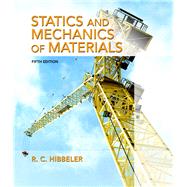For courses in introductory combined Statics and Mechanics of Materials courses found in ME, CE, AE, and Engineering Mechanics departments.
Statics and Mechanics of Materials represents a combined abridged version of two of the author’s books, namely Engineering Mechanics: Statics, Fourteenth Edition and Mechanics of Materials, Tenth Edition. It provides a clear and thorough presentation of both the theory and application of the important fundamental topics of these subjects, that are often used in many engineering disciplines. The development emphasizes the importance of satisfying equilibrium, compatibility of deformation, and material behavior requirements. The hallmark of the book, however, remains the same as the author’s unabridged versions, and that is, strong emphasis is placed on drawing a free-body diagram, and the importance of selecting an appropriate coordinate system and an associated sign convention whenever the equations of mechanics are applied. Throughout the book, many analysis and design applications are presented, which involve mechanical elements and structural members often encountered in engineering practice.
Also Available with MasteringEngineering
MasteringEngineering is an online homework, tutorial, and assessment program designed to work with this text to engage students and improve results. Interactive, self-paced tutorials provide individualized coaching to help students stay on track. With a wide range of activities available, students can actively learn, understand, and retain even the most difficult concepts. The text and MasteringEngineering work together to guide students through engineering concepts with a multi-step approach to problems.
Note: You are purchasing a standalone product; MasteringEngineering does not come packaged with this content. Students, if interested in purchasing this title with MasteringEngineering, ask your instructor for the correct package ISBN and Course ID. Instructors, contact your Pearson representative for more information.
If you would like to purchase boththe physical text and MasteringEngineering, search for:
0134301005 / 9780134301006 Statics and Mechanics of Materials Plus MasteringEngineering with Pearson eText -- Access Card Package, 5/e
Package consists of:
- 0134395107 / 9780134395104 MasteringEngineering with Pearson eText
- 0134382595 / 9780134382593 Statics and Mechanics of Materials, 5/e








